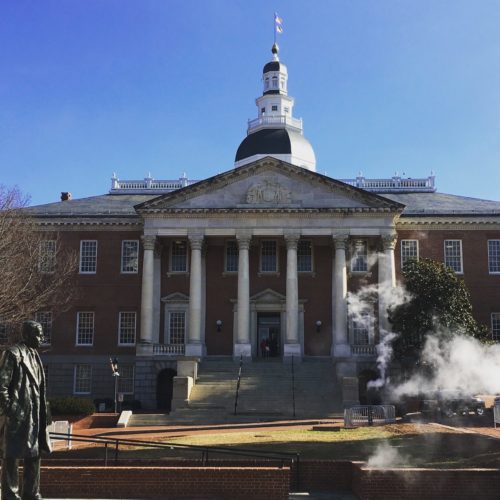CSG/ERC seminar at Penn addresses carbon policies, sustainable water infrastructure, and renewables
On May 6, CSG/ERC brought together legislators from around the Northeast and eastern Canada to discuss policies to reduce carbon emissions, expand access to renewable energy and electric vehicles and promote sustainable practices for managing urban water resources.

The meeting was hosted by the Kleinman Center for Energy Policy at the University of Pennsylvania, and allowed participants to share strategies for addressing a range of common policy goals, and discuss opportunities for collaborative approaches.
Mark Alan Hughes, faculty director of the Kleinman Center, provided an overview of the international climate accord completed in Paris last December, which was signed by the U.S. and nearly 180 countries last month. The accord marks the first time the global community has consented to a target for cutting planet-warming emissions. The historic agreement seeks to limit the rise in Earth’s temperature to 2 degrees C (3.6 degrees F) above pre-industrial levels. In reality, though, most scientists agree that the targeted cuts are not sizeable enough to prevent temperatures from exceeding that threshold, which creates greater urgency for the international community to accelerate their efforts to keep warming in check.
Hughes, the former sustainability director for the city of Philadelphia, discussed the collective action problem that economists often cite in relation to carbon policies: Almost all of the benefits of climate reductions tend to flow those residing outside of the location where those cuts were made. On a global scale, he noted, more than half of the pledges contained in the Paris agreement require actions among state and local governments to limit carbon emissions. He advised that officials in those “subnational” bodies focus on local strategies that will assist their economies the most, because often, they will produce the biggest net benefits for local populations, and the environment.
For example, policies driven by indigenous goals, like limiting harmful pollution to reduce respiratory-related illnesses and enhance human health, will likely lead to deeper emissions cuts than policies focused solely on climate benefits. Efforts to enhance building codes to encourage greater energy efficiency, or programs encouraging electricity system resiliency, like microgrids, are designed to yield immediate, tangible benefits, and tend to encourage greater enthusiasm, and compliance, Hughes said.
In recent years, 16 states — including nine in the Northeast — and 35 cities have resolved to lower their greenhouse gas emissions 80% from a 2005 (or lower) baseline by 2050. Hughes noted that despite these shared goals, it is probably not efficient to require that every state and urban center meet the same global target, given that local conditions will dictate the most effective strategies for making emissions cuts.
At the federal level, the Obama administration has devised policies intended to help meet a goal announced last year of cutting national emissions 26-28% below 2005 levels by 2025. The U.S. Environmental Protection Agency’s Clean Power Plan, which calls for a 32% reduction in carbon emissions from the nation’s power plants by 2030, is intended to help achieve that target. The rule was finalized last year, but in February, it was stayed by the Supreme Court pending judicial review. Other policies include increased vehicle fuel efficiency for cars and trucks, which will rise to 54.5 miles per gallon in 2025 under rules issued in 2012. It is generally understood that even if the Clean Power Plan is upheld by the Court, additional federal, state and local policies will be needed to meet the nation’s reduction goals.
During the meeting, participants discussed legislation that has been introduced at the state level, including revenue-neutral carbon pricing bills in Massachusetts and Rhode Island. The bills would levy a fee on fuels that emit carbon dioxide, and rebate 100% of the proceeds equally to all households. Both states participate in the nine-state Regional Greenhouse Gas Initiative (RGGI), which caps emissions from power plants that generate 25 megawatts or more of electricity.
Massachusetts State Senator Michael Barrett, who sponsored one of the proposals, S. 1747, noted that 80 percent of carbon emissions in the state come from cars and trucks, which are not covered by RGGI. His bill is intended to help Massachusetts meet the targets contained in the 2008 Global Warming Solutions Act, which calls for reducing economy-wide carbon emissions 25% below 1990 levels by 2020, and 80% by 2050.
Click here to view a presentation on the “Economic Impacts of Carbon Fees at the State and Local Level” from Scott Nystrom, Senior Economic Associate, REMI, Inc.)
Treating Water as a Sustainable Commodity
Participants also heard from former Philadelphia Water Commissioner Howard Neukrug, who addressed what he considers to be the biggest environmental problem in the U.S. today: the overflow of rainwater from impervious surfaces into our sewers.
“The challenge is that the world takes rainwater and doesn’t make it into a commodity—it has no value – and treats it as wastewater,” said Neukrug, who is currently a senior fellow at the US Water Alliance and a fellow at the Penn Institute for Urban Research.
As landscapes become increasingly urbanized, they are characterized by the steady replacement of pervious surfaces with impervious ones – e.g., asphalt roads cover former forests and farmland – leading to increased stormwater runoff and combined sewer overflows. Rainfall that once filtered through the soil gets funneled along manmade surfaces into underground sewers and dumped into waterways used for recreation and drinking water, picking up pollutants along the way.
The bottom line, said Neukrug, is that investing in a landscape-based approach to stormwater management, through the use of green infrastructure, offers a more cost-effective, environmentally friendly, and sustainable method for managing water resources compared with conventional “gray infrastructure” practices that favor expensive investments in tunnels and sewers. Tools include stormwater planters, green roofs and rain gardens that soak up some of the runoff and filter pollutants before the remaining stormwater flows into sewers.
Neukrug explained how the internationally acclaimed Green City, Clean Waters Plan that he developed for Philadelphia is helping the city comply with the Clean Water Act, and saving more than $5 billion that would have been spent on building pipes, tunnels and storage basins. The program is eventually expected to reduce the stormwater pollution flowing into local waterways by 85%.
“We’re looking at this as a major positive change for how Philadelphia is managing its water resources for several centuries to come,” he said.
During a roundtable discussion, participants also discussed efforts to broaden access to renewable energy in their states, through legislation to raise New Hampshire’s net-metering cap, a proposal to make solar power in Maryland cost-effective for low-income communities, and a recent agreement between investor-owned utilities in New York and solar companies to revise net metering for solar installations. Net metering is the compensation system that credits owners of solar installations for the excess power that they generate and sell to the grid. They also heard about Québec’s aggressive policies to promote an infrastructure for electric vehicles and to decarbonize the economy.
For more information, please contact rcohen@csg.org.





